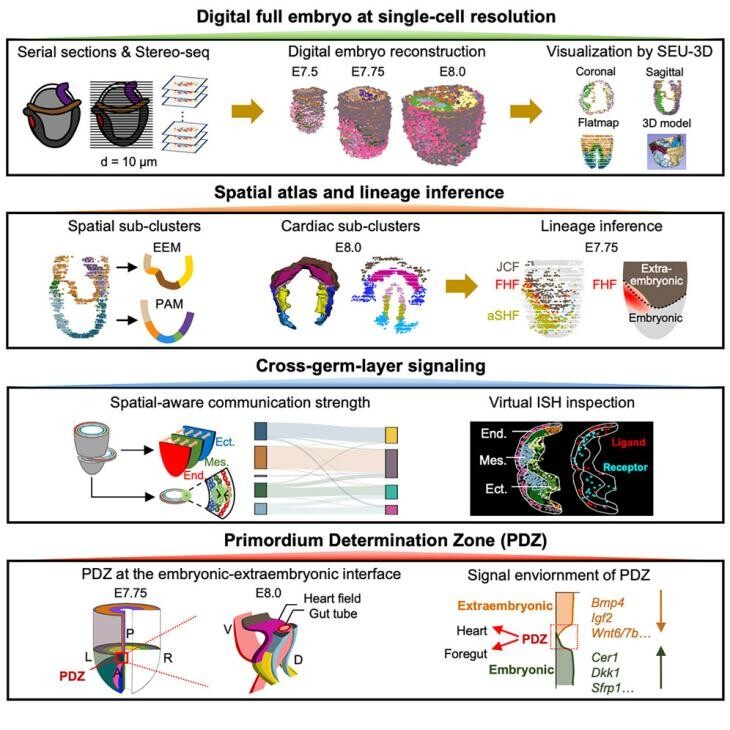All
Products
Resources
News
FAQ
Search
28/06/2025
SHENZHEN, China, June 28, 2025 — STOmics' Stereo-seq technology has been featured in three groundbreaking research studies published within just ten days in the world-renowned journals Cell and Science. These publications mark significant milestones in spatial multi-omics, showcasing Stereo-seq's critical role in advancing developmental biology, regenerative medicine, and molecular research.
On June 18, Cell published a study titled "Digital reconstruction of full embryos during early mouse organogenesis," presenting the world's first 3D "digital embryo" of mice at single-cell resolution. Utilizing Stereo-seq's ultra-high resolution spatial transcriptomic profiling combined with the SEU-3D platform, the study revealed critical signaling pathways involved in early organ development, including those guiding heart and foregut formation.

Spatial reconstruction of full mouse embryos
Credit: Xie, Peng et al./Cell, 2025
Researchers analyzed 285 serial sections from six embryos (E7.5–E8.0), identifying over 104,000 high-quality cells with precise spatial coordinates. The resulting atlas provides an invaluable resource for studying congenital defects and mammalian organogenesis. Stereo-seq data are available in GEO under accession GSE278603. The SEU-3D algorithm and code are accessible at https://github.com/RainyBlue-w/SEU-3D.
On June 26, a second Cell publication, "A Drosophila single-cell 3D spatiotemporal multi-omics atlas unveils panoramic key regulators of cell-type differentiation," offered a comprehensive spatial-temporal atlas across the full developmental trajectory of Drosophila melanogaster—from embryo to adult.
Leveraging Stereo-seq, the research team reconstructed over 3.8 million cellular compartments with spatial context. Key findings include the identification of the transcription factor Exex as a pivotal regulator in copper cell differentiation within the midgut.

Overall summary of this paper
Credit: Wang, Mingyue et al./Cell, 2025
This high-resolution multi-omics atlas is publicly available viaFlysta3D v2.0 (https://db.cngb.org/stomics/flysta3d-v2/), opening up new possibilities for comparative developmental studies in other model organisms.
Also on June 26, Science published “Reactivation of mammalian regeneration by turning on an evolutionarily disabled genetic switch,” highlighting a critical breakthrough in tissue repair and regeneration. Combining scRNA-seq and Stereo-seq, researchers mapped cellular responses during rabbit and mouse ear tissue regeneration and identified a previously uncharacterized retinoic-acid switch that governs regenerative capacity.
Stereo-seq spatially resolved cell populations and gene expression during wound healing. It identified Wound-Induced Fibroblasts (WIFs) as major drivers of regeneration and pinpointed key regulators, including Srfbp1 and Aldh1a2, with strong regenerative potential.
Molecular insights into mammalian tissue regeneration.

As Science Deputy Editor Stella Hurtley observes in her summary of the findings, modulating vitamin A metabolism 'could potentially provide a strategy for promoting regeneration in normally nonregenerative organs' - a discovery with profound therapeutic implications.
With over 200 peer-reviewed publications to date, Stereo-seq has become a cornerstone technology in spatial multi-omics. These three landmark studies not only validate its unmatched resolution and scalability but also demonstrate its profound impact on advancing life science research.
From embryonic development to tissue regeneration, Stereo-seq is enabling scientists to decode biology in ways never before possible.
"Digital reconstruction of full embryos during early mouse organogenesis" - https://www.cell.com/cell/fulltext/S0092-8674(25)00622-1
"A Drosophila single-cell 3D spatiotemporal multi-omics atlas unveils panoramic key regulators of cell-type differentiation" - https://www.cell.com/cell/fulltext/S0092-8674(25)00629-4
"Reactivation of mammalian regeneration by turning on an evolutionarily disabled genetic switch" - https://www.science.org/doi/10.1126/science.adp0176
Stereo-seq is STOmics' spatial multi-omics technology that integrates high-throughput spatial transcriptomics with nanoscale resolution and large-field capture. It empowers scientists to explore complex biological processes with unprecedented spatial precision, accelerating discoveries in development, disease, and regenerative biology.
➡ Learn more: STOmics Stereo-seq Solution